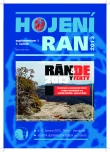Authors:
O. Assadian 1; T. Eberlein 2
Authors place of work:
Medical University of Vienna, Vienna General Hospital
1; Arabian Gulf University, Deutsche Wundakademie
2
Published in the journal:
Hojení ran 7, č. Supplementum 1: 23-24, 2013
Category:
Abstrakta
Introduction
There are huge numbers of different dressing materials existing on wound care market. With the exception of some very special materials a lot of these products aren’t unique. Indications and contraindications are often not unambiguously defined.
New techniques in topical wound management
A complete new principle in topical management of both acute and chronic wounds is the use of transforming particle dressing based on nanoflex technology (Altrazeal, ULURU Inc.). The term “nanoflex” must not be confused with “nano-particles”. The material consists of pHEMA/pHPMA polymers, which are synthesized as discrete particles with a minimum size of 63 µm. The “large” size of the polymer particles does not allow them to be regarded as true “nano-particles”. The particles aggregate irreversibly to form a solid gel material with a network of interconnected capillary channels. “Nanoflex” refers to the interconnected capillary channels which form between the discrete polymer particles. The capillary channels between the discrete particles are approximately 7 nm. The term “nanoflex technology” hence refers to this “nano-porous grid”, allowing hydration and transportation of fluids from the wound to the dressing’s surface.
Clinical use
The material adsorbs a total of 68 % of the hydrated mass of the material in water. This means that one gram will pick up 2.12 grams of fluid. It can remain in place up to 30 days as long as the wound produces exudate. The wound should be inspected for infection, inflammation, excessive bleeding or fluid, odour, and irritation. The dressing should be changed or removed if clinically necessary.
Additionally, we report clinical experience with this material in wound management.
Štítky
Chirurgia všeobecná Sestra Domáca starostlivosťČlánok vyšiel v časopise
Hojení ran

2013 Číslo Supplementum 1
- Metamizol jako analgetikum první volby: kdy, pro koho, jak a proč?
- Fixní kombinace paracetamol/kodein nabízí synergické analgetické účinky
- Antidepresivní efekt kombinovaného analgetika tramadolu s paracetamolem
- Kombinace metamizol/paracetamol v léčbě pooperační bolesti u zákroků v rámci jednodenní chirurgie
- 100 let s metamizolem: jaké je jeho současné postavení v léčbě bolesti
Najčítanejšie v tomto čísle
- K 35: Možnosti léčby vlhké gangrény prstů nohy při syndromu diabetické nohy
- K 16: Možnosti lokálního ošetření fasciotomie
- K 30: ReCell Spray–On Skin
- K 10: Doporučený postup v péči o nehojící se ránu – utopie anebo realita budoucnosti?
